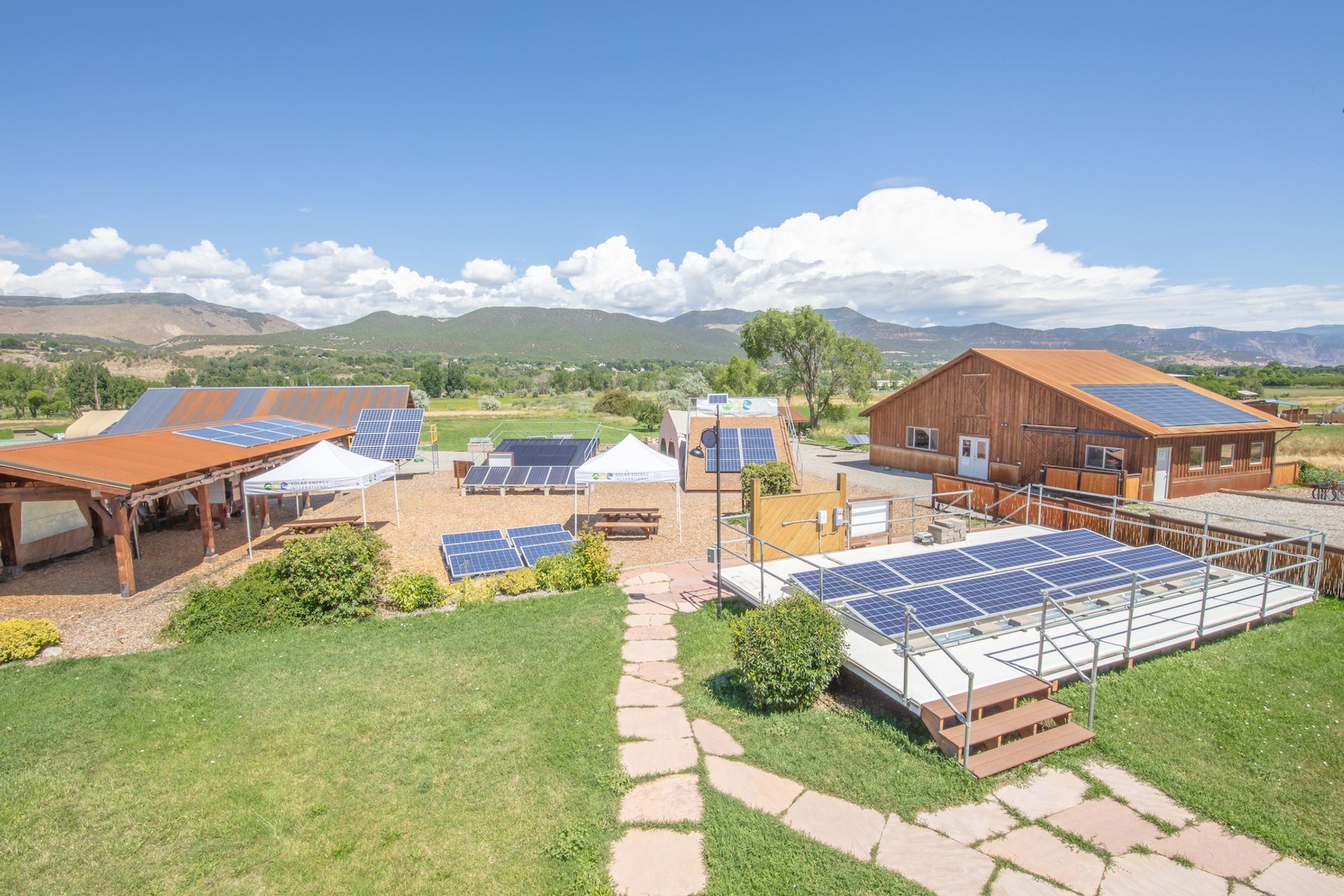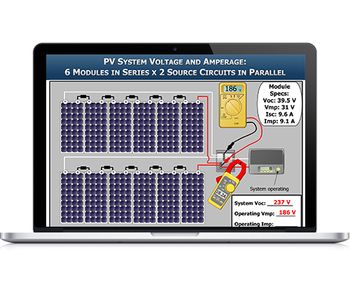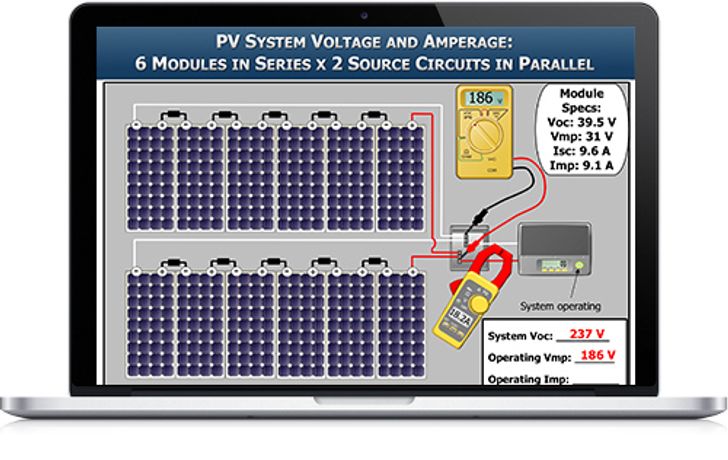
PV101: Solar Electric Design and Installation (Grid-Direct) Online Course
From Online Courses
PVOL101 is your gateway to a career in the solar industry. It all starts with the fundamentals, and a solid understanding of various components, system architectures, and applications for PV systems. Other topics include site analysis, system sizing, array configuration, and performance estimation; electrical design characteristics such as wiring, overcurrent protection, and grounding; a detailed look at module and inverter specifications and characteristics; mounting methods for various roof structures and ground-mounts; and an introduction to safely and effectively commissioning grid-direct PV systems. This course focuses on grid-direct PV systems, but covers material critical to understanding all types of PV systems. These core concepts are expanded on in SEI’s upper level PV courses. This course was recently refreshed – click here to see what’s been updated.
What you will Learn
Students who complete PVOL101 will be able to:
- Describe global PV and storage growth trends
- Communicate solar industry employment trends and options
- Identify the different components of PV systems and their functions
- Recognize the common types of PV systems, their major components, and applications
- Distinguish between systems that provide DC and/or AC power
- Recognize the features of interactive systems
- Interpret diagrams of systems to understand component interaction and power flow
- Interpret demand and PV production curves
- Define the two types of electrical current (AC and DC) and explain their differences
- Explain the relationship between: volts, amps, amp-hours, watts, watt-hours, and kilowatt-hours
- Perform power and energy calculations
- Describe typical electrical service voltages and equipment
- Examine power, energy, and demand / production curves
- Define utility bill terminology
- Describe PV metering options
- Compare incentive mechanisms for renewable energy installations
- Describe the differences and similarities between various PV cell technologies
- Compare module sizes and efficiencies
- Identify key components of a PV module
- Describe how a PV cell works
- Locate important points on the I-V curve
- Recognize how temperature and irradiance affect voltage and current
- Decipher important criteria on module specification sheets
- Explain how shading affects module production
- Identify meters used with PV systems
- List common functions of digital multimeters (DMM) and clamp-on ammeters
- Identify key points of meter use and safety
- Describe basic procedures for testing an operating PV system
- Define and list characteristics of series and parallel circuits
- Calculate values for current, voltage, and power for different PV module configurations
- Review the application series and parallel connections to ensure system compatibility
- Pre-qualify a customer
- Explain how remote site assessment tools are used
- Identify factors limiting system size
- Identify data required to size and design a grid-direct PV system
- Describe how the sun’s position in the sky changes daily and seasonally
- Determine azimuth and altitude angles of the sun using a sun chart
- Explain how the solar resource is measured in the context of power and energy
- Define factors that impact the amount of irradiance reaching a PV array
- Explain how array tilt angle and azimuth affect solar production
- Identify common approaches to PV mounting
- Evaluate characteristics of different mounting options
- Identify and define the function of the following on a three-line diagram of a grid-direct PV system: equipment grounding & conductors, ungrounded conductors, functionally grounded conductors, grounding electrode, grounding electrode conductor, electrical system grounding
- Define the functions of an inverter
- List the common types of inverters
- Recognize common inverter voltage characteristics and requirements
- Define the primary function of an inverter
- Identify the important information used to specify a grid-direct inverter
- Describe how the PV array voltage must fit within the inverter voltage window
- Identify the functions of grid-direct inverters
- List the common types of grid-direct inverters
- Differentiate between central and string inverters, and module-level power electronics
- Identify limits to PV system size
- Calculate PV array size using the online PVWatts tools: apply appropriate system loss factors
- Create charts for your location to aid in sizing estimates
- Determine the correct number of PV modules for a given application
- Demonstrate how temperature impacts PV voltage
- Describe why temperature is an important system design consideration
- Describe DC-to-AC power ration and how it applies to system design
- Explain when to use a higher or lower DC-to-AC power ration
- Describe criteria for different power electronics options in PV systems
- Determine the correct wiring configuration of PV modules and power electronics for a given application
- Define current and ampacity
- Identify and describe characteristics of conductor materials and insulations
- Differentiate between different conductor sizes
- Determine color coding of conductors based on wire type and circuit characteristics
- Identify terminology for the various circuits in PV systems
- Determine maximum current for PV system circuits
- Identify and describe considerations for selecting conductors to meet ampacity and voltage drop requirements
- Choose wire size for PV source circuits and inverter output circuits
- Explain the purpose of disconnects and overcurrent protection
- Identify the correct placement of disconnects and overcurrent protection
- Perform basic overcurrent device sizing for DC and AC PV system circuits
- Identify potential jobsite hazards and opportunities for additional safety training
- Determine proper Personal Protective Equipment (PPE) for PV installation and commissioning tasks
- Understand Lockout / Tagout procedures
- List 5 basic commissioning tests to be completed after a system is installed
Helpful Information
Prerequisites: Completion of our free online RE100 Introduction to Renewable Energy, is highly recommended.
ONLINE CAMPUS DETAILS: Students can log into their course at any time for the full duration of the specified course. The course is self-paced with no required log-in times, but all graded materials must be completed by the end date of the course. Live instructors give feedback, grade your work and answer questions in discussion forums or by email.
Click here for Computer & Software Requirements for online courses.
THE SOLAR ELECTRIC HANDBOOK (eBook version only) IS INCLUDED WITH YOUR REGISTRATION FOR PVOL101! If you would like to purchase a hard copy of this publication, you will be given the option to add it for a discounted price of $99 (retail $129) when selecting the dates for your training session.
NABCEP Certification Information
SEI Contact Training Hours: 6 Weeks Online = 60 hours
This course provides approved credit hours towards the following NABCEP Certifications and Recertifications:
- PV Associate
- PV Technical Sales Professional
- Solar Heating Installer (Recertification only)
Please visit NABCEP’S online course catalog for credit hours breakdown.
After successfully completing this course and PV203/PVOL203, you are eligible to sit for the NABCEP PV Associate Exam (PVA). The PVA Exam includes questions on grid-direct and battery-based PV systems. Check out our PVA Prep Training Package here, and for information on NABCEP and signing up for the PV Associate Exam please click here.
For information on SEI’s Solar Professionals Certificate Program please click here.
Customer reviews
No reviews were found for PV101: Solar Electric Design and Installation (Grid-Direct) Online Course. Be the first to review!


